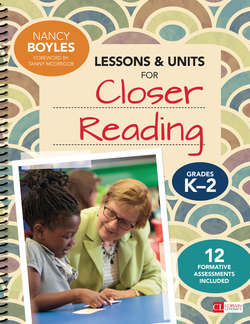Читать книгу Lessons and Units for Closer Reading, Grades K-2 - Nancy Boyles - Страница 60
На сайте Литреса книга снята с продажи.
How to Use the Active Reader Cards
Оглавление1 Copy and cut apart the Active Reader Cards: Summarizing a Story for students to use at the end of your lesson, making a set for each student or pair of students. (I place each set in a small envelope for easy distribution.) Copy the larger cards from the companion website to use with your whole class as you read the book for your initial close reading lesson. You will want to make sure that the story you are reading has a clear problem/solution format so these cards will completely support the text.
2 Before reading the book, review the story parts with your students. Remind them as well where they will most likely (but not always) find these parts within the story: characters, setting, and the problem gets started at the beginning; the problem gets bigger in the middle; the problem gets solved along with the ending at the end of the story. Kids love to act this out, holding a designated card and positioning themselves in the right place: beginning, middle, or end.
3 As you read aloud to students, repeatedly refer to the cards: Have we met any characters yet? Do we have a problem? Is the problem getting bigger? How?
4 At the conclusion of the story, use the set of large cards to summarize it. You might want to turn the pages of the book as you do this so students can see you’re relying on the text for accuracy.
5 Now distribute the small set of Active Reader Cards: Summarizing a Story and ask students to work with a partner to take turns summarizing the story orally. They should account for each card, step by step. Move from pair to pair as students summarize the story aloud, monitoring for accuracy and fluent language.
6 Invite a few students to share their summaries at the end of the session.
7 You can differentiate this lesson by asking students to identify just a few of these story parts; asking students to give you supporting details for each story part; or asking students to distinguish between actions in the story that would be included in a summary and descriptive details that do not contribute to the sequence of events.
